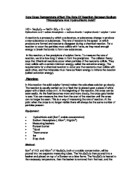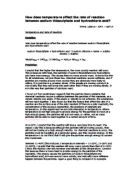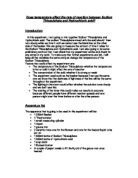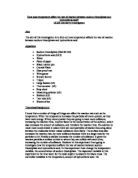Concentration – If you increase the concentration of a reaction solution you will increase the number of reacting particles in a given volume. Doing this will increase the chances of a successful collision.
Pressure – If the pressure is increased the particles in the gas are pushed closer. This increases the concentration and will increase the rate of reaction.
Surface Area – If you increase the surface area of a reacting solid you will make available more reacting solid particles therefore increase the chances of a successful collision. To increase the surface area of a reacting solid you powder it.
Catalyst – The presence of a catalyst in a reaction mixture reduces the activation energy so it increases the chances of successful collisions. Therefore increasing the rate of a chemical reaction.
To make this investigation fair I will keep all factors that affect the rate of a chemical reaction the same. I will make sure I keep the concentration and volume of the reacting solutions the same all the way through this investigation. The only factor that I will change is the temperature of the reacting solutions. To keep the concentration the same I will make enough reactant solutions stock to last the whole of the experiment without having to make a new stock that may be of a different concentration. I will not change the concentration of any of the reactant solutions.
To keep the volume the same I would measure the same volume of reactants every time. I will not include a catalyst in any of the reactions. I will carry out all the reactions under the same atmospheric pressure. This will make sure that the test is as fair as possible.
Apparatus:
- Hydrochloric Acid
- Sodium Thiosulphate
- 1 thermometer
- 2 measuring cylinders
-
1 beaker
- I conical flask
- 1 tripod
- 1 gauze Water Bath
- 1 heatproof mat
- 1 Bunsen burner
- Stopwatch
- White card with a black ‘X’ on it
- 1 pair of tongs
- 1 pair of goggles
- 1 Lab Coat
Method:
- Put on Safety Goggles and Lab Coat.
- Set up water bath as shown in the diagram.
- Use a measuring cylinder to measure 5cm³ of Hydrochloric Acid and 5cm³ of Sodium Thiosulphate into two separate test tubes and place them into the water bath to get them to the desired temperature with the use of a thermometer.
- Put conical flask on the centre of white card with the cross on it.
- Empty reactants from test tube into the conical flask simultaneously and start timer immediately and observe the black cross.
- Stop timer as soon as black cross on the white card under the reaction vessel (conical flask) is no longer visible.
- Record results on the results table.
- Wash out test tubes and conical flask with clean water and repeat test at the same temperature two more times.
- Wash out test tube and conical flask with clean water and repeat steps 3 to 8 at 20ºC, 30ºC, 40ºC, 50ºC, 60ºC and 70ºC.
Results:
Analysing Evidence and Drawing Conclusion
From the results my prediction was correct and the results proved my prediction. I predicted that when temperature increased the rate of reaction will increase. At 20ºC the average reaction time was 71.1secs. As the temperature increased to 30 ºC the average reaction time decreased to 37.7secs. At 40ºC the average reaction time was 37secs. At 50ºC he average reaction time 19secs. At 60ºC the average reaction time was 10.7secs and at 70ºC the average reaction time was 5.3secs. So as the temperature increased, the reaction decreased. In other words, the rate of reaction increased with increasing the temperature. As the temperature increased the reactant particles gained more kinetic energy. The chances of successful collision are increased so the rate of reaction is increased. This is better shown on the graph.
At 40 ºC the reaction time was usually long; it was 37secs. This anomaly may have been due to an error I made in my observation and recording of results. A graph of 1/T against temperature shows clearly that the rate of reaction increases as the temperature increases. It is a curve showing that the rate if reaction increases as temperature increases.
I can therefore conclude that when temperature is increased the rate of reaction increases and when temperature is decreased the rate of reaction decreases.
Evaluating Evidence: All the points do not fit on the graph perfectly. This shows that my results could have been collected more accurately. The solutions could have lost heat after taking it out of the water bath at different rates depending on how windy it was at the time of me mixing the solutions. I could also improve my experiment by using a pipette to measure the volumes more accurately. If I could find a way of preventing this unfair loss of heat from the flask as well as the use of a pipette I could get even much better results.
My procedure was good and easy to follow and this is shown in my results. However, I did not use an instrument to fine out whether I could see the cross or not so I could not record a number value for this. My eye could have detected this not to the same accuracy and precision. I could improve on my experiment by using a light meter instead of my eye to detect the end point of the reaction. Or I could have done an experiment which releases a gas given off to measure the rate of reaction, although my results were not so precise (close together). I took 3 readings and calculated the average in order to reduce the level of error. The quality of my results were good.
It would have been good to have done more repeats. Two teats were managed each time but if one had been wrong this could have dramatically changed the average time and therefore the rate of reaction.
All in all I think this was a successful experiment and the best that could have been done with the time and resources available. The results supported my predictions and they seem to be fairly reliable results.







